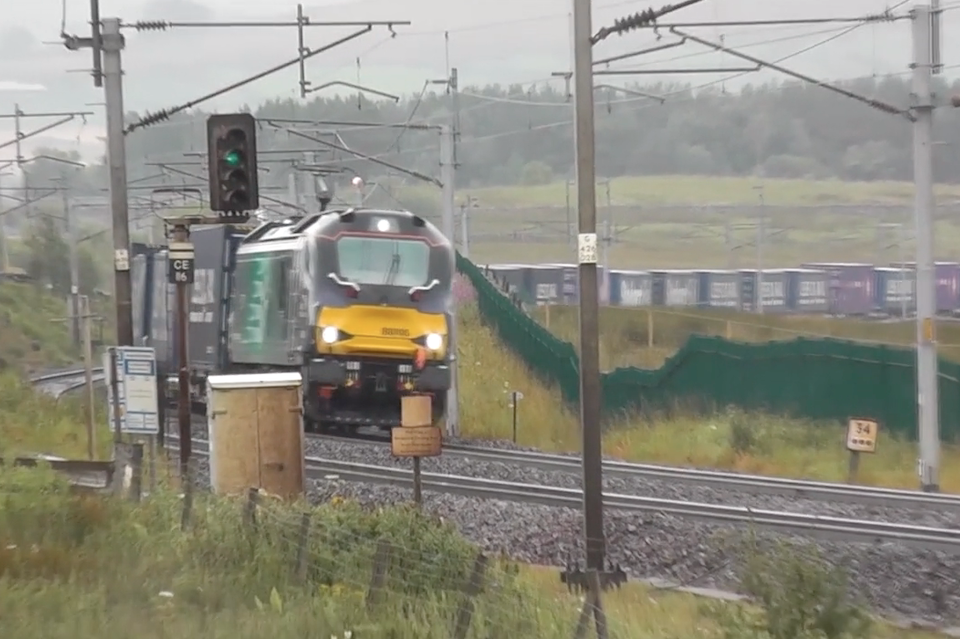Europe’s business mixed traffic line is underwater again. That’s proving a headache for freight as well as passenger operations. Severe flooding around Northampton has left the line submerged, and it has made a valuable freight route impassable.
Cancellations for passenger services have been the order of the day around Northampton and, for once, a rail replacement bus service won’t cut it. Maybe a rail replacement boat would be more useful. However, for many people, the flooding effects of Storm Bert have been no laughing matter. Homes and businesses have been flooded in Northampton and South Wales, and railway lines have not been spared.
Of national economic importance
A nationally recognised warning of danger to life has been issued for Northampton. That came in the early hours of Monday morning. Rainfall caused waterways to overflow, inundating parts of the town. That included the railway station and the West Coast Main Lake, as the WCML railway has become known. News reports say that five people were killed in storm-related incidents in the UK over the weekend. That puts into context the relatively minor matter of rail disruption.

Northampton is about as far inland as it’s possible to get in England. That hasn’t stopped an almost tidal flow of flood waters from submerging the line. The West Coast Main Line, connects the 400 miles (640km) between London and Glasgow. It only touches the coast briefly, near Morecambe Bay in the north of England. Nevertheless, it is a critical route for shipping goods around the UK. Disruptions are of national economic importance. A review of the railway disruption is available on our sister service, RailTech.com.
Operators face the storm
Freight operators have been stoic in the face of another country-wide storm event. Direct Rail Services, based in Carlisle, directly on the West Coast Main Line, could be forgiven for being despondent. However, their spokesman said that operations were continuing with diversions. The company has been known to go to lengths to keep its trains running. During a planned closure of the WCML, they diverted their intermodal trains, run on behalf of the supermarket chain Tesco.

Instead of running north from Daventry International Rail Freight Terminal in the English Midlands, they went south to London, and connected with the East Coast Main Line. From there, it was to Edinburgh to rejoin their original route north to Inverness. It’s not been quite as lengthy a diversion on this occasion, but the company is obliged to avoid Northampton. The East Coast Main Line, which is often a casualty of the weather, has been operating relatively normally.
Coastal erosions and port problems
The effects of Storm Bert have been severe. However, the nature of the weather event has left some parts of the UK unaffected, at the same time as other areas have been deluged. There has however been extensive collateral disruption for rail operations. Shipping, for example, has been extensively disrupted – and port operations are affected by high winds (the huge “ship to shore” cranes are vulnerable to high winds and cannot operate in the worst weather conditions. That can leave ships with several thousand containers still in the hold, even though the ship is safely in port. At Felixstowe, operations appeared to be running normally, despite some disruption south of Ely, reported by National Rail Enquiries on Monday afternoon.

The storm, which is still blowing through Great Britain, has caused other damage too. A landslide at Ulverston in Cumbria has blocked the line around the coast. That route serves the Sellafield nuclear reprocessing facility. An alternative approach can be made from the north, but passenger services are disrupted. Network Rail, which has not had a quiet start to the week, says the line will reopen with a speed restriction, while a longer plan for a permanent repair is undertaken.
Northampton particularly vulnerable
Northampton railway station is particularly vulnerable to flood issues. The station is bounded along its western edge by a stream, which flows into the River Nene, just a few hundred meters away. The flood incident on Sunday and Monday was due to the Rive Nene overflowing and the waters backing up into the floodplain – upon which the railway sits right in the middle.

The Northampton loop is a useful (and vital) freight route, which takes pressure off the main tracks of the West Coast Main Line. It’s so useful that work is currently underway to build the vast new SEGRO Logistics Park, which includes a rail freight terminal, to serve intermodal traffic, and also other traffic, including bulk aggregates and express logistics (parcels by another name).
“We’re working as quickly as we can to clean up and repair damaged rail equipment after major flooding through Northampton station following Storm Bert,” said Gary Walsh, director for Network Rail’s West Coast South route. “Due to the scale of damage caused to our signalling system by the flooding, we expect the railway to remain shut throughout Tuesday 26 November.”
When this report was filed (on Monday evening, 25 November) there were still 120 flood warnings in place across the UK.